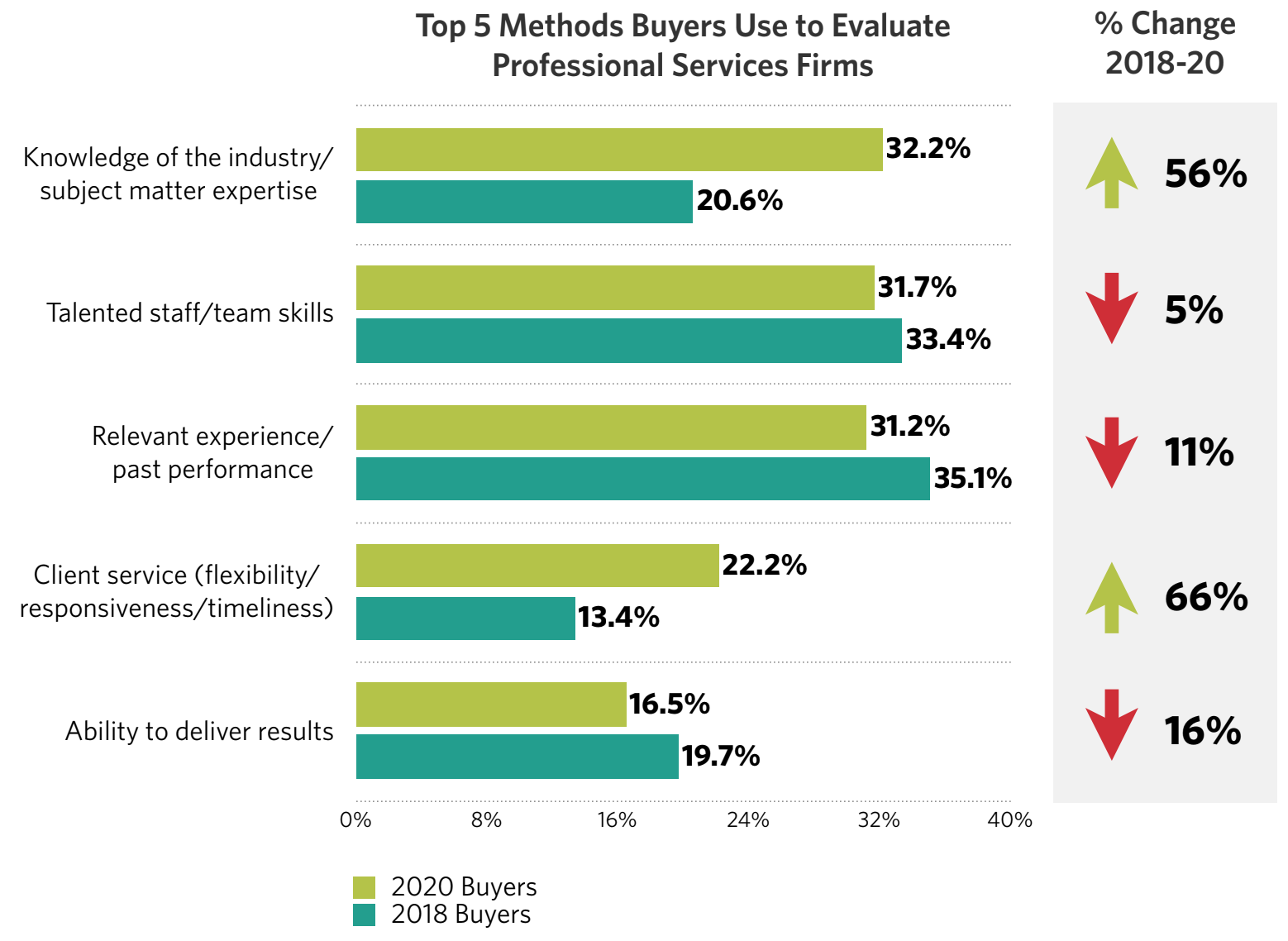Few would argue with the notion that building business relationships is critical in professional services. And while marketing efforts typically focus on pricing and service strategy, or articulation of a firm’s competitive position, their real advantage lies in the strength of their relationships.
An important body of Hinge’s research, Inside the Buyer’s Brain, Third Edition, found that most buyers who are trying to select a firm rely heavily on a firm’s relevant experience and expertise. These factors are represented by two of the top three bars in the chart below. This makes intuitive sense — if buyers know you are an expert in your service area, they are more likely to buy from you.

Just like any personal relationship, business relationships require continual maintenance. A mutual benefit and ongoing communication are important ingredients to success. In the long run, having close and trusting contacts will give you an edge, especially when other marketing tactics aren’t working. Here are 5 keys to building and maintaining business relationships:
1. Routinely Reach Out to Important Contacts
It is impossible to have weekly or monthly conversations with all of the contacts in your CRM system. But you can focus on the valuable ones. Pinpoint your best clients, partners, and vendors and continually check up on them. Express your interest in their business and let them know that you are here to help. If you want to keep the relationship alive make this outreach routine. If you let too much time go by, your eventual contact will seem less genuine. And don’t ignore the power of your LinkedIn connections. When executed properly, a social media strategy is the digital sister to in-person networking – and it can be fast and efficient way to ensure your are routinely reaching out.
2. Offer Help Before You Ask for Help
Building business relationships doesn’t mean tapping into your resources whenever you need something. If the only time you ever contact a former client is when you have a new service offering, your gesture won’t seem authentic. Similarly, if you call your vendor only when you are looking for a good deal, don’t expect to get one.
Spend time figuring out how you can help your important business contacts. What value can you offer to spark the conversation?
3. Ask for Feedback
Instead of assuming your clients and vendors are happy, ask! Open communication is a basic component of any relationship. When you ask your contacts how they feel, you promote a two-way conversation that can uncover areas for improvement. Some firms conduct client satisfaction surveys to gather feedback. But usually it’s best to pick up the phone and talk to your closest contact at a firm. If this is your top client, you want to make sure they are content.
4. Find Ways to Connect with Less Valuable Contacts
As new contacts enter your world, try to build trust over time with email marketing. Because you can’t interact with everyone in your email address book on a weekly basis, leverage technology to do some of the work for you.
Customer relationship management (CRM) systems allow you to set up email sequences that will routinely send email to your contacts. This is no substitute for a real relationship, but it will at least keep your firm on the top of people’s minds.
Note that this does not mean blasting your list with non targeted emails. Instead, focus on educational content that your audience will find relevant and practical. There are two types of emails to consider:
- Educational emails provide content that is meant to be informative. These emails give something of value to the reader without asking for anything in return. Because educational emails are highly valued by your audience, they should make up about 80% of the emails that you send out.
- Offer emails are for when you want the recipient to do something, such as download a presentation or paper, and you are hoping to move them to a deeper level of engagement. Whether this engagement is a meeting or trying out one of your services, you want them to take a specific next step. Although offer emails should account for the other 20% of emails, you wouldn’t want to send these until you’ve created value for your audience. And offer emails should only go to folks who have already downloaded several pieces of your content. Unless specifically requested, you absolutely would not want an offer email to be sent to someone you just met at a networking event.
Here are a few tips we’ve discovered for highly effective email marketing:
- Ensure the look and feel of your email reflects your brand at every touchpoint.
- Ensure they are mobile friendly.
- Segment your distribution list so you can be strategic about which emails go to which list.
- Remember the 80/20 rule. No matter how many or how few emails you send out, the balance of them (80%) should be educational, while the remainder (20%) are offers.
- Make sure you have a way for people to unsubscribe.
- Consider the subject line carefully. To encourage high open rates, go with 40 characters or less, and be very clear. Subject lines aren’t the time to be too clever or leave too much up to the reader’s imagination. Just say what the email is about. Trust us, the payoff will be there.
- Lastly, be aware that there are certain trigger words that can send your email straight into the spam or junk folder. Words like “cheap” or “sale,” and sometimes even “free,” when placed in the subject line can signal the email is spam and it won’t get through the filter.
5. Educate, don’t sell.
If building relationships requires trust and credibility, then educating – as opposed to selling – is a big enabler of professional services relationships.


